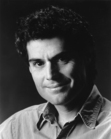Michael Shapiro's Blog, page 6
May 1, 2017
Nat Geo: Top 10 Secrets of the Maya
People often ask me what my favorite destination is – I don’t have just one but I always include Guatemala, the hub of the Maya world, in my top 5. When National Geographic asked me to share some secrets I leapt at the opportunity. Here’s the story on Nat Geo’s site: Top 10 Maya Secrets.
By Michael Shapiro
1. The Mayans haven’t disappeared
Just as the fall of Rome hasn’t meant the end of Romans, the decline of great Mayan metropolises, such as Guatemala’s Tikal which reached its apex in the 9th century, doesn’t mean the indigenous people have vanished. According to the CIA World Factbook, 40 percent of Guatemala’s 14 million people are Mayan, and southern Mexico and the Yucatan are home to many more predominantly Mayan regions. Not only are Mayans enduring almost five centuries after the Spanish conquest, but their cultural traditions, agrarian lifestyle, and celebratory festivals continue on. There are more than 20 distinct Mayan peoples within Guatemala, each with their own culture, style of dress, and language, and millions more Mayans live beyond the borders.
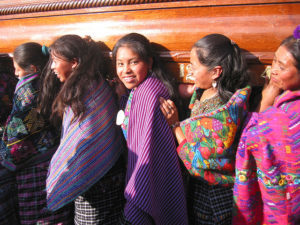
A heavy wooden float honoring the Virgin Mary at a festival near Antigua in January 2006. Photo by Michael Shapiro
2. The land is volcanically alive
A chain of volcanoes runs through Guatemala and several of these remain active. From the tourist-friendly town of Antigua, Guatemala, you can often see Fuego Volcano puffing out plumes of smoke or jettisoning fiery tendrils lava, especially vivid at night. Not far from Antigua (about 90 minutes drive) is Pacaya Volcano, which has been erupting continually for years. Travel agents in Antigua sell day tours on which you can hike to within a few yards of molten lava and feel its heat. I kept my distance but our guide got so close he lit his cigarette with the lava’s heat; the ground was so warm his sneakers started to melt.
3. Ancient Mayans loved blood sports
At the center of many Mayan cities was a ball court where teams of the best athletes would try to vanquish one another. The heavy soccer-sized ball was made from hard rubber; some scholars have suggested that human skulls may have occasionally been used as balls. The games, like our Olympics, were cultural spectacles followed by human sacrifices. What we don’t know is whether it was the winners or losers who were offered to the gods. A guide in Tikal firmly believes it was the winners. “Morir en Tikal es un honor,” he told me atop a lofty temple. Translation: to die in Tikal is an honor.
4. Mayans developed the concept of zero
The Mayans’ remarkable Long Count calendar relies on the concept of zero. The concept of zero may have originated in Babylonia around 300 BCE, but the Mayans independently conjured the notion of zero, likely in the 4th century. Zero in the Mayan written language was typically represented by a shell-shaped glyph. The Mayan numerical system is based on factors of 20. So Mayan numbers are composed of units of 1, 20, 400, and so on. To write the number 403, for example, a Mayan would use a symbol for one unit of 400, zero units of 20, and three units of 1. That’s how the they derived the concept of zero.
5. Mayans didn’t believe the end of the world was coming
Apocalyptic movies may have suggested Mayans believed the end of the 5,000-plus-year calendar was an end-times moment, but that’s not how the local people think. Most Mayan people may celebrated the beginning of the new 5,125-year cycle of the Long Count calendar in 2012 just as we celebrated the new millennium. But they don’t believe the end of the world is on the horizon. If anything, they’re hopeful that a new era will usher in an age of higher consciousness, greater peace and enhanced understanding among the diverse peoples on the planet. For most Mayans, Dec. 21, 2012 was be just another day.
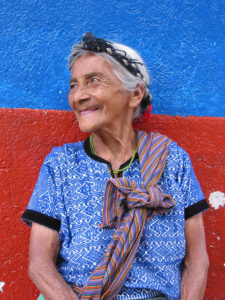
A Mayan woman near Guatemala City. Photo by Michael Shapiro
6. Whitewater rivers traverse the Mayan world
When most people think about whitewater rafting in Central America, they think of Costa Rica. But Guatemala has world-class boating, such as the intermediate (Class III) Rio Cahabon, which is not just an exhilarating ride but a way to meet local Mayans, who come out to see rafters in their jungle encampments. The Usumacinta River runs along the border of Mexico and Guatemala – river trips stop at ruins such as Piedras Negras, on the Guatemala side of the border. An American woman, Tammy Ridenour, has been running river trips and leading adventure tours in Guatemala for more than two decades, www.mayaexpeditions.com.
7. Much of the Mayan world remains underground
Major Mayan sites, like Palenque and Chichen Itza in southern Mexico, have been largely excavated, but others remain buried under more than a millennium of earth. Even Tikal, the most famous ruin in Guatemala, has mounds that conceal what could be great temples. Lesser-visited Mayan sites, such as the sprawling El Mirador and Uaxactún, both just north of Tikal in Guatemala’s Petén jungle, are only fractionally unearthed and thrilling to visit for the sense of discovery. Belize, too, has its share of barely-excavated ruins, such as Altun Ha, just 30 miles from Belize City. You can see monumental pyramids at all these sites, but so much more remains.
8. Some Mayan pyramids were built to reflect astronomical events
It’s no secret that Mayans were advanced astronomers – what’s lesser known is that many great Mayan structures, such as the El Castillo (Kukulkan) pyramid at Chichen Itza, reflect astronomical events. During equinoxes, an undulating shadow called the “snake” slithers along the side of Kukulkan’s northern staircase. This is caused, only on an equinox, by the angle of the sun hitting the nine main terraces. Also at Chichen Itza is El Caracol, known as The Observatory, which is linked to the orbit of Venus. El Caracol’s front staircase targets Venus’ most northern position, and the corners of the building align with the sun’s position at the summer solstice sunrise and winter solstice sunset.
9. Mayans built saunas
Ancient – and some modern – Mayans enjoyed steamy stone saunas, known as the temascal in the Yucatan, or chuj in the Mayan language of Mam. The Mayan sauna is still popular and offered to visitors at hotels and resorts throughout the Mayan world. Ancient Mayan cities built saunas of stone or adobe mud – these were used for health and spiritual fulfillment. Mayans combined water with fire-heated rocks to create steam, and sometimes elder leaves were added to the mix. “After a time you’ll note that you’re sweating,” blogged a Peace Corps volunteer in Guatemala in 2011, “and that a layer of grime, what they call grasa, seems to be lifting itself from your skin – and your mind.”
http://people-as-guate.blogspot.com/2...
10. No one knows what caused the rapid decline of Mayan civilization
Starting in the 8th century and accelerating in the 9th, Mayan cities suddenly declined; their people either died or retreated from these great metropolises. Cultures that had developed highly advanced irrigation, agriculture, astronomy and building techniques, as well as intricate social structures, rapidly fell apart. No one knows why. Among the theories: increased war among Mayan city-states, overpopulation that led to environmental degradation such as depleted soil, and climate change resulting from deforestation. Other theories suggest that the enlargement of the ruling class of royalty and priests created an imbalance with not enough productive workers. Likely it was a combination of the above factors; we may never know.
—
Bio: Michael Shapiro is co-author of Guatemala: A Journey Through the Land of the Maya and author of A Sense of Place. To see more of his writing, visit www.michaelshapiro.net
March 6, 2017
Napa Valley’s most unlikely grape spirit
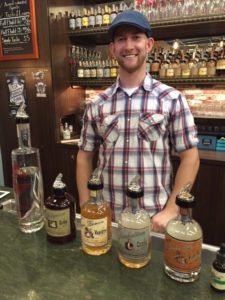 In Napa’s Oxbow Public Market, near the Napa River, we came upon the tasting room for the Napa Valley Distillery. I’d heard good things about their spirits, but what first caught my eye was the table crowded with hundred of little bottles of bitters. Among them were 18 varieties of orange bitters, a Negroni bitter from Australia, even a foggy pudding bitter.
In Napa’s Oxbow Public Market, near the Napa River, we came upon the tasting room for the Napa Valley Distillery. I’d heard good things about their spirits, but what first caught my eye was the table crowded with hundred of little bottles of bitters. Among them were 18 varieties of orange bitters, a Negroni bitter from Australia, even a foggy pudding bitter.
The self-described “spirit educator” behind the bar, Tim Johnston, said this outpost of the nearby Napa Valley Distillery had the largest selection of bitters on the West coast, including a couple of antique bottles. He showed me two ancient bottles of Abbott’s bitters, one of which predated Prohibition. “We have two of the remaining 10 bottles of Abbott’s bitters in the world,” he said. And yes they’re for sale: one is $1,500, the other $750.
Then we started tasting the distillery’s spirits, first a vodka made from Sauvignon – Johnston said Napa Valley Distillery is the first to make this clear spirit from grapes, which are distilled twice and filtered 10 times. For reasons that remain less clear than Stoli, in California this craft spirit can’t be called vodka so the distillery calls it “neutral brandy.”
Next my wife and I tasted Napa Valley Distillery’s renowned Old Hollywood gin, made with nine botanicals. Like most gins it had the scent of juniper – Johnston says gin is really the first flavored vodka. But when the Old Hollywood hit the tongue, I could taste the botanicals, including cloves, cinnamon, and cardamom. It sparkled and popped with distinct flavors.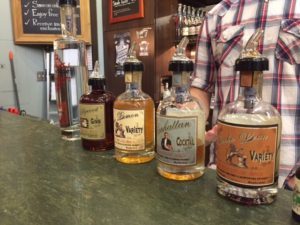
The distillery also makes premixed cocktails, and their Manhattan is good to go, just chill and pour. I would have bought a bottle but it was so smooth I probably would have consumed it in one evening.
We capped our tasting with the Ancho Leon, a chili-infused brandy aged in baby bourbon barrels for six to twelve months. The spices hit just the right notes with aftertastes of coffee and chocolate, which for me makes this the ideal after-dinner drink.
Johnston is easygoing, knowledgable and convivial, a natural bartender. But he’ll only be at the tasting room a few more weeks – he’s enlisted in the Navy and is leaving the distillery next month. I hope that after his years of service behind the bar he gets to take some fine bottles of spirits with him.
Note: Napa Valley Distillery has the tasting room at Oxbox and offers tours at distillery 2485 Stockton St., Napa. For info and reservations, email tastings@napadistillery.com or click here.
January 24, 2017
Shapiro wins 2016 Explore Canada Award of Excellence for fish story
My story about sustainable seafood in Vancouver won the 2016 Explore Canada Award of Excellence last fall which was gratifying because it was one of those stories I did in hopes of making a difference. Our oceans have been overhunted and polluted to near the breaking point but a group of chefs in Vancouver is seeking to stem the tide and their influence is being felt across Canada.
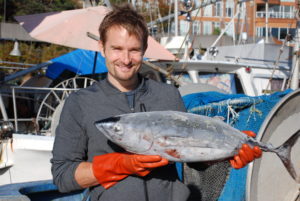
Chef Ned Bell of the Four Seasons’ YEW restaurant, buys sustainable fish from fishermen at the city’s wharf.
The announcement of winners is here — the other two North American winners were from the L.A. Times and Washington Post. Thanks to judge Gail Simmons, the Canadian food writer and Top Chef personality, who selected my entry as the winner of the Culinary category.
Destination Canada even made a 2-minute video about the story, calling it a “tantalizing article,” the first time I’ve ever had one of my stories made into a video.
In announcing the award, Simmons said: “In his in-depth exploration of Vancouver’s seafood restaurant scene, Michael Shapiro not only thoroughly and thoughtfully explains the timely issues surrounding ocean sustainability and the efforts being made by Vancouver to improve it, but also succeeds in making me very, very hungry for the extraordinary and often unlikely ingredients used by the city’s most talented and conscientious chefs.”
I’ve only been to Vancouver twice, but each trip has been revelatory and I’m hungry to return.
An short version of the story appeared in March 2016 issue of Virtuoso Traveler and the longer piece, which won the award, appeared in the Fall 2016 issue of Inspirato magazine.
November 29, 2016
Science writing tips for California Academy of Sciences workshop
Tips for Science Writing
California Academy of Sciences workshop
Omit needless words: And make every word count – ask what it adds. Do flight attendants need to say “at this time”? Does anyone need to say “obviously”?
Accuracy is essential: If you make spelling mistakes or factual errors you lose credibility.
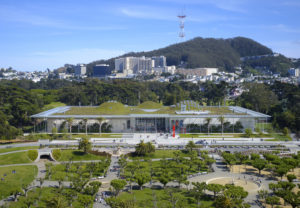
California Academy of Sciences, San Francisco
Be concise: Attention spans today are very limited so don’t ramble on – get to the point.
Think like a journalist: Consider what’s unique, surprising or compelling about your topic. Think about what you’d tell a friend about it – what makes you say wow?
Use the active voice, not the passive: Avoid phrases like “can be heard” in passages like: “When an alligator snaps its jaws shut, a loud sound can be heard.”
Evoke all the senses not just sight: What does something sound like, feel like, smell like?
Show, don’t tell: Rather than describing something can you show how it works? Don’t say “The octopus is a crafty predator” – show me how it attacks and consumes its prey.
Be as specific as possible and use vivid details: Rather than say a flower is red, use a more specific color – is it scarlet, ruby, or maybe burgundy?
See the world with fresh eyes, or what Buddhists call Beginner’s mind: try not to overlook something because you’re overly familiar with it – the reader might not be.
Know your audience: Are you writing for kids, for seniors – or for scientists or lay people? This should determine your approach.
Join a writers group: At best, a writers group is a supportive community offering honest feedback. But don’t take all criticism as gospel – listen to it, incorporate what feels right, but remember it’s your work. Just because someone has a suggestion doesn’t mean you have to incorporate it.
Read the Elements of Style by Strunk and White: It’s a primer on cleanliness, accuracy, precision, and brevity in writing.
Here’s what the adventure writer Tim Cahill says about hooking readers. I asked him how he gets readers interested in what he’s seeing during his travels. This is an excerpt from my book A Sense of Place:
“Why do different animals eyes shine differently in light at night? Why are some red — why are some green? Some say, well predators have the red eyes, and prey populations like deer have the green eyes, and I wondered whether that was true or not. But here’s the thing: I find the answer is fascinating; it’s a scientific principle of reflection that has to do with a coating on the back of the eyeball.
So if I said, “Reader I’m going to tell you about a coating on the back of the eyeball that reflects light back through the pupils and makes animals eyes shine. …” Some people may read it and some may not. But if I put you into a dark forest and I have a light and I start shining it around and I’m looking at all these different colored eyes staring at me, then the reader may be ready for me to tell him what I know about why animals’ eyes shine differently. The reason I put that stuff in there is that I just found it fascinating. But I can’t put it in the purely scientific or historical stuff until I’ve aroused the reader’s curiosity to the point where the reader might say, “I wonder why that is.” And if I’m really good it that’s when I come in and say, “That’s because…”
August 13, 2016
The Art of the Interview, Book Passage, Aug. 2016
Easy Listening: The Interviewer’s Art
By Michael Shapiro
Introduction: Interviewing is something most writers do, yet doing it well is challenging. A successful interview combines thoughtful questions, rapt attention, and deft spontaneity. It brings out the best in both the interviewer and interviewee and shares insights with the reader, listener or viewer. Following are some suggestions for conducting a successful interview.
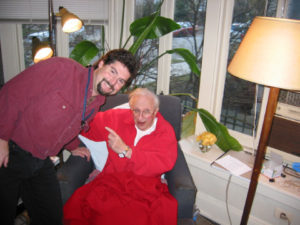
Michael Shapiro after interviewing the great conversationalist Studs Terkel in 2006 at his home in Chicago. The interview was published in The Sun magazine.
Do your homework: Read articles and use the Net to learn as much as possible about that person in the time you have to prepare. Google is helpful for digging up archive
d interviews. Look up, for example, “Smokey Robinson” and “interview” in the same search.
Study the material to prepare: The interviewee will know quickly whether you’re prepared. “If you don’t know much,” says Terry Gross, host of NPR’s Fresh Air, “you won’t get much.”
Talk to friends, colleagues and family: If possible, talk to people who know the interviewee to get background material. Example: I called Arthur Frommer’s daughter before interviewing him and got some great insight about his early career.
Work with others to develop questions: Terry Gross works with three producers who help her script questions. I worked with my editors at Travelers’ Tales to develop questions, especially early in conducting the interviews for A Sense of Place. Sometimes before an interview I’ll post on Facebook asking: “What would you ask…” and I get some useful questions.
Spark their interest: Think about what they might want to talk about that they haven’t yet had a chance to discuss. It could be a new book, an avid interest, or an area where they’ve felt misunderstood. Bring up issues you want to discuss later in the interview.
Avoid early confrontations: Start with friendly, but not fawning, questions. If you’re going to be provocative or challenging, do so later in interview after developing a base of trust. At the outset, you want to get the interviewee on your side by showing you care about them. Start with topics you expect they’d like to discuss. Once the interviewee trusts you, she’ll go places with you that she might not go with others.
Customize your questions: Tailor questions to the interviewee. This is especially important with a collection like A Sense of Place to ensure the conversations are distinct from one another. A set template of questions will bore the reader and won’t get the most from the interviewee.
Don’t fear silence: A technique I learned as an investigative reporter was to let someone finish what they’re saying and then wait. They’ll feel compelled to fill the silence and will often say something especially revealing. I don’t use this technique often but it can be valuable.
Push back against recalcitrant responses, but don’t be adversarial for the sake of generating controversy. Don’t be afraid of hostility, says Terry Gross: conflict can make for a good interview. When Paul Theroux asked me “Is that a serious question?” I didn’t get overwhelmed or intimidated. I told him, Yes, this is a serious question and then told him why as I asked it again. Then I got a great answer. (This was when I asked him why he lives on Oahu and Cape Cod; after I pushed back he told me Oahu for his love of marine sunlight and quoted a Phoenician saying that a day spent on the water is a day not deducted from your life.
Follow your instincts: When you hit paydirt, mine that vein. Go deeper. If you’re fascinated that probably means the reader or listener will be fascinated too.
Have a script but be spontaneous too: Write questions in a narrative order to give the interview flow, but be spontaneous too. Let new questions be triggered by what the interviewee says.
Avoid judgment. This is crucial. If a subject feels judged in any way, he or she will almost certainly shut down.
Listen! This is one of the most important, most obvious and most overlooked interviewing skills. It’s easy to think about what you’ll ask next, but some of the most illuminating segments of my interviews come from spontaneous interaction. Stay with your subject and follow him or her into unexplored territory. My interview with Pico Iyer is an example of this. As they say in Vegas: “you must be present to win.”
Learn from the masters: Read and listen to the top interviewers. My favorites are Bill Moyers, Michael Krasny (of KQED’s Forum, a San Francisco radio show), and NPR’s Ira Glass and Terry Gross. Among the master interviewers on our faculty are Don George and Phil Cousineau.
—
Michael Shapiro interviewed 18 of the world’s leading travel writers in his book A Sense of Place: Great Travel Writers Discuss Their Craft, Lives, and Inspiration. He met these writers where they live, interviewing Frances Mayes in Tuscany, Jan Morris in Wales, Peter Matthiessen at the east end of Long Island, Simon Winchester in Great Barrington, Mass., Bill Bryson in New Hampshire, and Arthur Frommer in New York City. A Sense of Place has been hailed by National Geographic Traveler as “a wonderful book, full of literary and experiential allusions — a fascinating read.” The Washington Post likened Shapiro to Charlie Rose but “less long-winded,” and the Chicago Tribune called Shapiro’s interviews “illuminating, entertaining and insightful.”
Shapiro’s articles appear in National Geographic Traveler, The Washington Post, San Francisco Chronicle and national magazines. He won a 1998 Lowell Thomas award in the category. A Sense of Place won a bronze medal in the ForeWord Magazine Book of the Year awards and was a finalist for the 2005 Independent Publisher Book Awards. He’s also the recipient of the 2007 Bedford Pace award for best travel story about Great Britain and is a four-time winner of the Travel Classics award.
-end-
August 11, 2016
Tracking elusive pumas in Patagonia, Summer 2016
Typically when traveling overseas I like to stay a while. But when an editor emailed and asked if I’d be willilng to travel to Patagonia to track pumas for a week in the dead of the southern hemisphere’s winter, I leapt at the chance even though I couldn’t extend my stay. The journey involved an overnight flight to Santiago, Chile, another flight south to almost polar town Punta Arenas and then a four-hour drive north to Torres del Paine, the national park in Chilean Patagonia. It was a long way to go but well worth it to see the park’s legendary mountains, cobalt lakes, ubiquitous guanaco, and to wake before dawn in hopes of sighting a puma.
Here’s the link to the PDF of my story in Private Clubs magazine, which goes to members of country clubs. The text, with a couple of paragraphs that were cut from the published story, follows below:
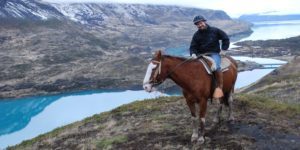
The author on horseback in Patagonia’s Torres del Paine national park.
Story and photos by Michael Shapiro
Well before dawn our Jeep crawls over the deserted roads that traverse southern Chile’s Torres del Paine national park, searching for pumas. The day before, my guide and I had spotted puma tracks and scat while hiking, lending support to another guide’s comment that “puma are everywhere” in this park, the jewel of Chile’s Patagonia region.
Even after downing a cup of yerba mate, the popular South American tea, I’m still groggy as our Jeep cuts between a pair of lakes known as Las Mellizas (The Twins) in the predawn darkness.
“Keep your eyes open,” guide Beatriz Castro, from an outfitter called Quasar Expeditions, says to me and two other guests as she shines the Jeep’s headlights into the hills. “Eight eyes are better than two.” She drives slowly as we round a bend, and I glimpse a flash of orange. “Slow down!” I say. “I saw something.” Probably just a gray fox or a reflector, I think, worried I’d sounded a false alarm.
Then I see the twin orbs shine in our headlights. The outline of the cat’s face comes into view, its ears pricked up in keen attention. It regards us for several seconds, scampers a few steps up the dusty hillside, then turns sideways. We can see the full outline of its muscle-bound body: its broad shoulders, thick paws and sinewy torso. I’d wondered how a two-foot high puma could take down a much larger guanaco (a relative of the llama and camel that thrives in Patagonia) but in that thrilling moment it all became clear.
Pumas are fierce, highly elusive creatures, and I’d traveled many thousands of miles to see one. Though I’d come to Torres del Paine, last August in the depth of the southern hemisphere’s winter, to see puma, it was the park itself that left the deepest impression.
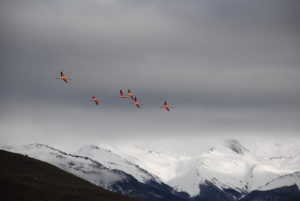
Pink flamingos soar above a lake in Torres del Paine.
Torres del Paine is best known for its soaring granite towers that rise thousands of feet above the valley below. The park — a World Heritage Site, with its luminescent cobalt rivers (paine means blue in the indigenous Tehuelche language), otherworldly rock formations, gargantuan glaciers, turquoise lakes and crashing waterfalls — remains wild and vibrantly alive. Moderate day hikes lead to the base of the Torres and the Cuernos, as well as to iceberg-filled lakes and spirit-lifting waterfalls such as Salto Grande, a riverwide series of cascades.
Torres del Paine receives 150,000 visitors a year (a small fraction of those who enter major U.S. parks such as Great Smoky Mountains, which had more than 10 million in 2014), but most of those come during summer. So the Chilean winter (June-September) can be the best time to experience Torres del Paine and soak up its 935 square miles of untamed beauty, a season when you can hike for miles without seeing another soul.
Getting to the park isn’t easy: it’s a 10-hour flight from New York to Santiago, Chile’s capital, then a three-and-a-half-hour flight to Punta Arenas in southern Chile, followed by a five-hour drive to the park. The good news: the small airport in Puerto Natales, just 90 minutes from Torres del Paine, is expanding and projected to start receiving flights from Santiago in late July, 2016, according to Chile’s tourism bureau.
Several hotels offer lodging within the park, but there are few luxury options. We stay at the Explora Patagonia where the cuisine is exquisite, the well-stocked bar is hosted, and every room has a jaw-dropping view of Los Cuernos (The Horns), one of the parks signature rock formations. Located in the heart of the park, the hotel is a 5-minute walk from the Salta Chico waterfall, and Explora drivers meet all guests at the airport.
After the predawn puma sighting we drive slowly looking for more big cats but reach a ranger station without seeing any. We watch Torres del Paine’s towers turn orange in the day’s first light, then learn we’ll continue our safari on foot.
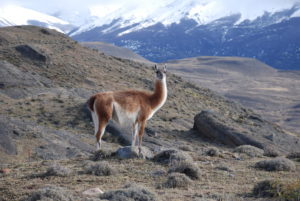
Guanacos, related to camels, are plentiful within the park’s borders.
Isn’t that dangerous? Castro assures us we’ll be fine. We’ll be accompanied by a veteran tracker, Jose Vargas, who tells us the cats are more scared of us than we are of them. For good reason: Ranchers shoot pumas to protect their sheep and other livestock, or contract hired guns called leoneros to take down the big cats for them.
We walk uphill along a fence line on the park’s boundary, past frozen puddles and the frost-crusted skeletal remains of downed guanacos. The pumas are expert killers, with the ability to sprint at speeds up to 50mph, Vargas says, and they’re smart. The cats run guanaco into the wire fence, where they pounce on the overmatched prey and sink their razor-sharp teeth into the guanacos’ necks. After the cats have had their fill, Andean condors, with bodies as big as wild turkeys and a 10-foot wingspan, consume the scraps.
Two guests in our group move at a glacial pace, photographing seemingly every guanaco bone, puddle and vista. “Don’t worry,” Vargas says with a laugh. “The puma always eat the slow ones.” Though evidence of puma is everywhere, we don’t see another cat, and by late morning we quit searching, knowing they’re bedding down for the day.
The weather is remarkably fair: mostly sunny and relatively mild (highs around 40F), though one night we get a light dusting of snow, adding luster to the landscape. It’s not windy, unlike in summer when hikers are buffeted by full-force gales.
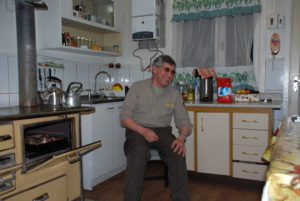
Ranger Juan Toro at his home in Torres del Paine in August, 2015.
The following evening we combine searching for puma with a visit to the home of 63-year-old ranger Juan Toro, who’s been patrolling the park, on foot and horseback, for 41 years. The park, says its longest-serving ranger, “es como mi casa” (is like my house). He extols the virtues of visiting Torres del Paine in winter: “You have the park to yourself – that’s the big difference.” The he offers me a gourd of mate (pronounced mah-tay), the stimulating tea that fuels Patagonians.
This is the last of my four nights in the park and I ask the gregarious gaucho what he wants visitors to remember: “All this landscape,” Toro says with a sweep of his arm. “All this beauty.” I tell him I will and that my only regret is I didn’t have more time in this primeval paradise. “You really need to 10 days to explore this park,” he says. “A lot of people regret that they’re on a set schedule and have to leave. Everyone says, ‘Oh we should have stayed longer.’ ”
I didn’t encounter another puma, but there were other wildlife sightings: the armadillo on the trail to the base of Los Cuernos, a pair of ostrich-like rhea in a mating dance, two condors on the ground inspecting a carcass, and countless inquisitive guanacos on hillsides and atop ridges. Naturally, I would have enjoyed seeing more pumas, but it was enough to be in the big cats’ presence, knowing they’re out patrolling this sublime landscape, atop the food chain, keeping the ecosystem in balance.
—
Explora Patagonia: explora.com
Quasar Expeditions: quasarex.com
August 10, 2016
Kauai still a Dream Trip, Islands
Islands magazine sent me to the Garden Isle of Kauai to write a feature for its Dream Trips issue which marked the magazine’s 25th anniversary. I was honored to have my essay appear among stories written by Pico Iyer, Don George, Patricia Schultz and Jeff Greenwald, but most of all appreciated the opportunity to write about my favorite island in the world. To read the story, see the text below or better yet click here.
—
KAUAI: FINDING MANA
By Michael Shapiro
Towering above the north shore of Kauai, just west of Hanalei, is the soaring spire of “Bali Hai,” known to Hawaiians as Mount Makana. Made famous in the 1958 movie South Pacific, the verdant pinnacle of Makana juts skyward above 700-year-old taro terraces. Centuries ago, Makana was one of only two places where ‘oahi – fire-throwing ceremonies – were held on special occasions, such as the arrival of a visiting chief or a hula school graduation. Young men climbed the treacherous 1600-foot peak carrying light, tapered logs from papala or hau trees. After dark they set the shafts on fire and hurled them into the night. Caught by updrafts, the javelins seared tracers into the darkness, often traveling a mile or more before sizzling into the sea.
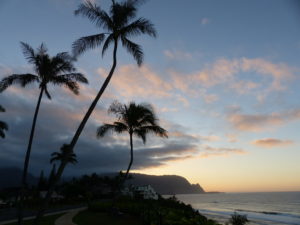
Kauai’s north shore, photo by Jacqueline Yau.
The ‘oahi ceremony is history, but it was this image that burned itself into my memory after my first visit to Kauai and pulled me back to the island last spring. At Mount Makana, I could sense, almost like a type of gravity, what Kauaians call mana, a spiritual power.
Naturally I yearned to return to Kauai’s uncrowded golden beaches, to swim in its warm clear waters, and to snorkel with rainbow-striped fish and tranquil sea turtles. But first things first: coming back to Kauai’s north shore, I went straight to the slopes below Mount Makana. Gentle, floral-scented breezes perfumed the air as my wife and I walked among the native plants and Polynesian imports at Limahuli, the botanical garden below Makana. Carpeted with lush green shrubs, Makana reached heavenward and I found myself drawn closer to its base. Standing still I could almost feel a low vibration, a sense I’d finally returned to a sacred place that had been calling me back for years. I silently thanked the ancestral guardians of Makana and moved on.
On the other side of Mount Makana is the dramatic Na Pali coast: Picture a 4,000-foot-high green accordion, tilt it at a 45-degree angle, and squeeze it tight to get an idea of the shape of Na Pali’s steep, sharp cliffs that plunge into the Pacific. Our senses came alive as my wife and I hiked along Na Pali’s narrow Kalalau Trail: vivid doesn’t begin to describe the shades of green covering much of its iron-red slopes. Contrasted with the turquoise and royal blues of the ocean, Na Pali provides a feast for the eyes. Our ears were enraptured by the rhythmic concert of waves pounding against the cliffs. Our skin tingled, caressed by soft, salt-tinged gusts, while the scent of plumerias and a bouquet of red, orange and yellow flowers turned the trail into a natural aroma-therapy treatment.
Climbing and then descending along a muddy ribbon of trail, we reached the seaweed-covered rocks of Hanakapi’ai Beach. At the blissfully uncrowded beach, we took a few deep breaths of the bracing sea air and turned inland. Clambering over rain-slicked boulders for a couple of miles, we came to the fern-shrouded 300-foot shower of Hanakapi’ai Falls, immersing our mud-spattered legs into its chilly pool. After the grueling hike, this instant refreshment felt deeply cleansing. We were ready for the return trip.
Retracing the four miles trail, we made our way back to one of the most magnificent trailheads in the world: Ke’e Beach, which offers the drop-dead view of the Na Pali coast and easy swimming and snorkeling. At this northern tip of the Na Pali coast, a reef subdues the breakers and provides food and habitat for all sorts of colorful fish. After longing to return to this mystical outpost for four years, I simply waded waist-deep into the warm, buoyant sea and planted my snorkel into the water. Surrounding me were foot-long fish with neon blue and yellow stripes and boxy fish with dorsal polka dots.
A four-foot-long green sea turtle swam a couple of feet in front of my mask, gracefully paddling above the reef. This encounter felt like a gift – I’d never have gotten so close to a turtle but this one approached me, took a quick look at me and seemed to nod, I imagined as a blessing, and nonchalantly swam on. As in the Galapagos Islands, animals in Kauai, ranging from red-headed cardinals to the Humuhumunukunuku apua’a (the official state fish), are comfortable among people and don’t seem to mind close encounters.
But when an endangered monk seal hauled itself onto the beach, officials set up barrier tape around it to keep onlookers at a safe distance. Just when we thought it couldn’t get any better, a pod of humpback whales appeared in the distance, slapping tails and fins on the ocean’s surface. Suddenly one of these huge animals heaved itself out of the water and then another whale soared into the air – then they both slapped sideways against the sea.
My wife and I found that every day in Kauai made us swoon: one day it was a rainbow plunging into the pellucid sea, the next day a sunset that turned the sky into a smoldering fire. Another day we gaped at Waimea Canyon, often called the Grand Canyon of Hawaii, a dark red cleft in the earth carved over millions of years by the Waimea River. Ten miles long, a mile wide and 3600 feet deep, the sculpted canyon is laced with waterfalls that project rainbows when illuminated by the setting sun.
Kauaians have managed to live on their tiny circle of land without dominating it. By law, no building can be higher than the tallest palm tree (about 40 feet). But it’s not laws that keep Kauaians from despoiling their island – it’s reverence for the beauty of their island. The locals’ appreciation for the land and its bounty is part of Kauaians’ daily lives: on a Saturday in Hanalei we visited the farmers market, where spikes of red-ginger flowers glowed like torches and spiky red rambutan (the fruit is similar to lychee) went for $5 a bag.
We passed one rainy afternoon (the north shore can be rainy; sun worshipers may want to stay down south around Poipu Beach) at a slack-key guitar concert. Twice a week at the Hanalei community center, Doug and Sandy McMaster play the authentic acoustic music of the islands (he on guitar, she on ukulele) and discuss slack-key’s roots. The mellifluous slack-key sounds seemed to bring out mynah birds who chirped along with the songs. Perfected suited to the languid pace of the island, slack-key developed after a few Mexican cowboys shared their guitars with Hawaiians in the 19th century. The music transported us to a simpler time on the island, when families gathered around suckling pigs and entertained one another with their own music and stories.
Not surprisingly, slack key tunings come from relaxing the guitar’s strings. Before leaving the Big Island of Hawaii, the Mexican vaqueros gave their guitars to Hawaiian paniolos (cowboys). The Hawaiians loosened the strings by turning the guitar’s keys and made them slack. “They created tunings that sounded good without chords,” Sandy said, adapting the guitars to Hawaiian vocal stylings and improvising to make the guitars their own.
Our too few days on the North Shore flew by. Paul Reiser writes that even when a dog is on a walk, you can shout “walk” and the dog will get excited. That’s how I feel about Kauai: mention the idea of a trip there and my heart jumps – even if I’m on the island. As our departure approached there seemed only one sensible course of action. I called the airline, extended our trip, and savored the prospect of two more days on Kauai.
For our final Kauaian sunset, we returned to Ke’e Beach with a bottle of Korbel Brut. We weren’t the only ones with Champagne: down the beach a couple was getting married as the sky turned shades of burgundy, mauve and pink. In the distance, Mount Makana loomed over us. As the sky darkened, a streak of light shot across the foreboding sky. Logic would say it was a bolt of lightning, but in this magical place, where anything seemed possible, I imagined an ancient warrior atop Makana, hurling fiery javelins into the night.
—
Where to Stay
The Hanalei Colony Resort, five miles west of Hanalei and on the ocean, rents two-bedroom condos with kitchenettes, $210-$375. 800-628-3004 or www.hcr.com. Also on the north shore is the upscale Princeville Resort with golf course and spa, from $465 a night, www.princeville.com.
The Sheraton Kauai Resort is on Poipu Beach. Lu’au are held beachside on Monday and Friday evenings. The $25-per-night resort fee includes breakfast for two, free Net access in the library, and mai-tais at cocktail hour. From $355. 866-716-8109 or www.sheraton-kauai.com.
The Waimea Plantation Cottages, one to five bedrooms, $140 to $730. Call 800-9-WAIMEA or visit waimea-plantation.com.
Dining
Naniwa at the Sheraton in Poipu Beach offers fresh sushi – the poke appetizer is outstanding, from $25 per person. Tuesday to Saturday from 6pm, 808-742-1661.
Waimea Brewing Company features upscale pub grub from $12 a plate, on the grounds of the Waimea Plantation Cottages. 808-338-9733.
Postcards Cafe in Hanalei features fresh local fish (the wasabi-crusted ahi is to die for) and organic veggies in an old plantation house, 808 826-1191.
Hamura Saimin in Lihue has the best noodle soup on the island. Counter seating encourages diners to meet the neighbors, but observe the sign: “Please do not stick gum under the counter.” 2956 Kress St. Open for lunch and dinner until 10pm, till midnight on Friday and Saturday nights, 808-245-3271.
Kauai still a Dream Trip, Islands magazine
A decade ago, Islands magazine sent me to the Garden Isle of Kauai to write a feature for its Dream Trips issue. I was honored to be among stories by Pico Iyer, Don George and Christine Richard, but most of all appreciated the opportunity to write about my favorite island in the world. To read the story, see the text below or better yet click here.
—
KAUAI: FINDING MANA
By Michael Shapiro
Towering above the north shore of Kauai, just west of Hanalei, is the soaring spire of “Bali Hai,” known to Hawaiians as Mount Makana. Made famous in the 1958 movie South Pacific, the verdant pinnacle of Makana juts skyward above 700-year-old taro terraces. Centuries ago, Makana was one of only two places where ‘oahi – fire-throwing ceremonies – were held on special occasions, such as the arrival of a visiting chief or a hula school graduation. Young men climbed the treacherous 1600-foot peak carrying light, tapered logs from papala or hau trees. After dark they set the shafts on fire and hurled them into the night. Caught by updrafts, the javelins seared tracers into the darkness, often traveling a mile or more before sizzling into the sea.

Kauai’s north shore, photo by Jacqueline Yau.
The ‘oahi ceremony is history, but it was this image that burned itself into my memory after my first visit to Kauai and pulled me back to the island last spring. At Mount Makana, I could sense, almost like a type of gravity, what Kauaians call mana, a spiritual power.
Naturally I yearned to return to Kauai’s uncrowded golden beaches, to swim in its warm clear waters, and to snorkel with rainbow-striped fish and tranquil sea turtles. But first things first: coming back to Kauai’s north shore, I went straight to the slopes below Mount Makana. Gentle, floral-scented breezes perfumed the air as my wife and I walked among the native plants and Polynesian imports at Limahuli, the botanical garden below Makana. Carpeted with lush green shrubs, Makana reached heavenward and I found myself drawn closer to its base. Standing still I could almost feel a low vibration, a sense I’d finally returned to a sacred place that had been calling me back for years. I silently thanked the ancestral guardians of Makana and moved on.
On the other side of Mount Makana is the dramatic Na Pali coast: Picture a 4,000-foot-high green accordion, tilt it at a 45-degree angle, and squeeze it tight to get an idea of the shape of Na Pali’s steep, sharp cliffs that plunge into the Pacific. Our senses came alive as my wife and I hiked along Na Pali’s narrow Kalalau Trail: vivid doesn’t begin to describe the shades of green covering much of its iron-red slopes. Contrasted with the turquoise and royal blues of the ocean, Na Pali provides a feast for the eyes. Our ears were enraptured by the rhythmic concert of waves pounding against the cliffs. Our skin tingled, caressed by soft, salt-tinged gusts, while the scent of plumerias and a bouquet of red, orange and yellow flowers turned the trail into a natural aroma-therapy treatment.
Climbing and then descending along a muddy ribbon of trail, we reached the seaweed-covered rocks of Hanakapi’ai Beach. At the blissfully uncrowded beach, we took a few deep breaths of the bracing sea air and turned inland. Clambering over rain-slicked boulders for a couple of miles, we came to the fern-shrouded 300-foot shower of Hanakapi’ai Falls, immersing our mud-spattered legs into its chilly pool. After the grueling hike, this instant refreshment felt deeply cleansing. We were ready for the return trip.
Retracing the four miles trail, we made our way back to one of the most magnificent trailheads in the world: Ke’e Beach, which offers the drop-dead view of the Na Pali coast and easy swimming and snorkeling. At this northern tip of the Na Pali coast, a reef subdues the breakers and provides food and habitat for all sorts of colorful fish. After longing to return to this mystical outpost for four years, I simply waded waist-deep into the warm, buoyant sea and planted my snorkel into the water. Surrounding me were foot-long fish with neon blue and yellow stripes and boxy fish with dorsal polka dots.
A four-foot-long green sea turtle swam a couple of feet in front of my mask, gracefully paddling above the reef. This encounter felt like a gift – I’d never have gotten so close to a turtle but this one approached me, took a quick look at me and seemed to nod, I imagined as a blessing, and nonchalantly swam on. As in the Galapagos Islands, animals in Kauai, ranging from red-headed cardinals to the Humuhumunukunuku apua’a (the official state fish), are comfortable among people and don’t seem to mind close encounters.
But when an endangered monk seal hauled itself onto the beach, officials set up barrier tape around it to keep onlookers at a safe distance. Just when we thought it couldn’t get any better, a pod of humpback whales appeared in the distance, slapping tails and fins on the ocean’s surface. Suddenly one of these huge animals heaved itself out of the water and then another whale soared into the air – then they both slapped sideways against the sea.
My wife and I found that every day in Kauai made us swoon: one day it was a rainbow plunging into the pellucid sea, the next day a sunset that turned the sky into a smoldering fire. Another day we gaped at Waimea Canyon, often called the Grand Canyon of Hawaii, a dark red cleft in the earth carved over millions of years by the Waimea River. Ten miles long, a mile wide and 3600 feet deep, the sculpted canyon is laced with waterfalls that project rainbows when illuminated by the setting sun.
Kauaians have managed to live on their tiny circle of land without dominating it. By law, no building can be higher than the tallest palm tree (about 40 feet). But it’s not laws that keep Kauaians from despoiling their island – it’s reverence for the beauty of their island. The locals’ appreciation for the land and its bounty is part of Kauaians’ daily lives: on a Saturday in Hanalei we visited the farmers market, where spikes of red-ginger flowers glowed like torches and spiky red rambutan (the fruit is similar to lychee) went for $5 a bag.
We passed one rainy afternoon (the north shore can be rainy; sun worshipers may want to stay down south around Poipu Beach) at a slack-key guitar concert. Twice a week at the Hanalei community center, Doug and Sandy McMaster play the authentic acoustic music of the islands (he on guitar, she on ukulele) and discuss slack-key’s roots. The mellifluous slack-key sounds seemed to bring out mynah birds who chirped along with the songs. Perfected suited to the languid pace of the island, slack-key developed after a few Mexican cowboys shared their guitars with Hawaiians in the 19th century. The music transported us to a simpler time on the island, when families gathered around suckling pigs and entertained one another with their own music and stories.
Not surprisingly, slack key tunings come from relaxing the guitar’s strings. Before leaving the Big Island of Hawaii, the Mexican vaqueros gave their guitars to Hawaiian paniolos (cowboys). The Hawaiians loosened the strings by turning the guitar’s keys and made them slack. “They created tunings that sounded good without chords,” Sandy said, adapting the guitars to Hawaiian vocal stylings and improvising to make the guitars their own.
Our too few days on the North Shore flew by. Paul Reiser writes that even when a dog is on a walk, you can shout “walk” and the dog will get excited. That’s how I feel about Kauai: mention the idea of a trip there and my heart jumps – even if I’m on the island. As our departure approached there seemed only one sensible course of action. I called the airline, extended our trip, and savored the prospect of two more days on Kauai.
For our final Kauaian sunset, we returned to Ke’e Beach with a bottle of Korbel Brut. We weren’t the only ones with Champagne: down the beach a couple was getting married as the sky turned shades of burgundy, mauve and pink. In the distance, Mount Makana loomed over us. As the sky darkened, a streak of light shot across the foreboding sky. Logic would say it was a bolt of lightning, but in this magical place, where anything seemed possible, I imagined an ancient warrior atop Makana, hurling fiery javelins into the night.
—
Where to Stay
The Hanalei Colony Resort, five miles west of Hanalei and on the ocean, rents two-bedroom condos with kitchenettes, $210-$375. 800-628-3004 or www.hcr.com. Also on the north shore is the upscale Princeville Resort with golf course and spa, from $465 a night, www.princeville.com.
The Sheraton Kauai Resort is on Poipu Beach. Lu’au are held beachside on Monday and Friday evenings. The $25-per-night resort fee includes breakfast for two, free Net access in the library, and mai-tais at cocktail hour. From $355. 866-716-8109 or www.sheraton-kauai.com.
The Waimea Plantation Cottages, one to five bedrooms, $140 to $730. Call 800-9-WAIMEA or visit waimea-plantation.com.
Dining
Naniwa at the Sheraton in Poipu Beach offers fresh sushi – the poke appetizer is outstanding, from $25 per person. Tuesday to Saturday from 6pm, 808-742-1661.
Waimea Brewing Company features upscale pub grub from $12 a plate, on the grounds of the Waimea Plantation Cottages. 808-338-9733.
Postcards Cafe in Hanalei features fresh local fish (the wasabi-crusted ahi is to die for) and organic veggies in an old plantation house, 808 826-1191.
Hamura Saimin in Lihue has the best noodle soup on the island. Counter seating encourages diners to meet the neighbors, but observe the sign: “Please do not stick gum under the counter.” 2956 Kress St. Open for lunch and dinner until 10pm, till midnight on Friday and Saturday nights, 808-245-3271.
August 9, 2016
Paul Theroux’s Cape Cod, Inspirato, Summer 2015
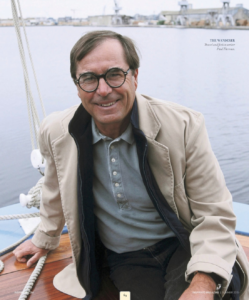
Author Paul Theroux has long felt at home when surrounded by water.
I first interviewed Paul Theroux in 2004 for my book, A Sense of Place, a collection of interviews with the world’s leading travel writers. Though some consider him brusque, blunt and — this irritates him the most — curmudgeonly, I found him to be engaging and genuinely interested in me when we met in San Francisco. We spoke again in 2015 for this story on Cape Cod and how his adopted home has become so important not just for his personal happiness but for his writing life.
Here’s the PDF, the text of the story is beneath it:
Paul Theroux story for Inspirato, Summer 2015
By Michael Shapiro
At first glance it might seem surprising to find the roving travel writer and novelist Paul Theroux spending his summers on Cape Cod. Best known for unflinching accounts of extended, gritty journeys, Theroux helped redefine modern travel writing with his 1975 book, “The Great Railway Bazaar,” an account of his train journey across Europe in Asia.
A sharp counterpoint to much of the travel writing of the time, Theroux called it as he saw it, and if readers found him cranky or harshly critical, so be it. That didn’t stop them from buying his books, including novels such as The Mosquito Coast, by the millions. “I think the people who read my books and like them, and there are plenty of them, wouldn’t read me if I were merely a bad-tempered person,” Theroux told Salon.com.
Into his later years, Theroux has sought rigorous overland trips, such as a journey that took him across thousands of miles of rutted roads in Africa, recounted in 2002’s Dark Star Safari. So why does this itinerant scribe keep coming back to Cape Cod? There’s fresh air, sand, and sea (he’s an avid kayaker), and of course history (it’s where the Pilgrims landed in 1620), but most of all it’s become his home.
“What a writer needs most is solitude, monotony, routine, security, encouragement and happiness – and, for me, sunshine and the comforts of home,” he said in an interview for this article. “All my life I have worked to create an ideal place to live and work in, a happy house in a pleasant place.”
Theroux, who turned 74 in April (2015), and his extended family gather on the Cape each summer; he lives with his wife Sheila on Oahu during the winter months.
He wouldn’t compare his family to the Kennedys, who famously shared a compound on the Cape in Hyannis Port, but there are some similarities. Like the Kennedys, the Theroux clan has more than one shining light: Paul is the brother of authors Alexander Theroux and Peter Theroux, and his sons Louis and Marcel are successful writers as well.
When I interviewed Theroux in February, he said the family was preparing to celebrate the 104th birthday of his mother, Anne Theroux. But she died just days later, less than a week shy of that birthday. “My mother’s extreme longevity has kept the family together,” he told me just before she passed. “We are still children, still siblings.” After she died, Theroux said: “The fact that she was with us for so long makes it all the harder to contemplate her passing.”
* * *
Paul Theroux said he’s been able to travel rough for months on end because of the sense of place, of belonging, he’s found at his home, located near Sandwich on the Upper Cape, quite close to the residences of other family members. In an essay in Sunrise with Seamonsters, Theroux writes that were it not for the cozy contentment he finds on Cape Cod, “I think it would have been impossible for me to travel or stay away for any length of time.”
And in Fresh Air Fiend, he notes that the Cape has been a lodestone for him, its magnetic allure pulling him back into the fold after every extended journey. “It is my home, so it is in my dreams,” he writes, “a landscape of my unconscious mind, perhaps my mind’s only landscape.”
The writer Nicholas Delbanco, who lives on Wellfleet, on the Cape’s wilder eastern side where the land juts north into the Atlantic, said that although his friend Theroux is a “high profile” author, he doesn’t seek attention or the perks of fame. “That’s congenial to the New England sensibility and Cape Cod in particular,” said Delbanco, author of the recently released novel, The Years. “For New Englanders that sense of rootedness is crucial. And for a guy who has spent so much of his life wandering, it’s no surprise that he would also have a place where the roots go deep.”
Naturally, Theroux isn’t the first writer to find solace on the Cape, which he calls “this handle-shaped piece of geography, swinging from the crankcase of the Bay State.” With its golden beaches, windswept shorelines, whitewashed clapboard houses, spirit-lifting vistas, and promise of solitude, the hooked peninsula has long been a summertime getaway for artists, writers and others who seek to escape the hubbub and frenetic pace of urban life.
Since the formation of the Provincetown Players in 1915, the first theater company devoted to producing original works by American playwrights, the Cape has opened its arms to writers, establishing a tradition of appreciation for the arts. Among those who have spent time on the Cape over the years: Henry David Thoreau, Eugene O’Neill, Tennessee Williams and poet Mary Oliver.
But perhaps none of these writers has been as intrepid as Theroux. Known locally for paddling his kayak around the Cape, he has embarked on potentially treacherous solo journeys to the nearby islands of Martha’s Vineyard and Nantucket. The naturalist Edward Hoagland recalled that Theroux used to paddle from Hyannis Port to the Martha’s Vineyard home of author William Styron and pull up his kayak on Styron’s beachfront yard.
Theroux said the potential dangers of paddling around the Cape tuned his senses to hazards while traveling abroad. “This complex landscape has taught me ways of measuring the world of risk,” he writes in “The True Size of Cape Cod,” an essay in Fresh Air Fiend. “But the word ‘landscape’ presents a problem on the Cape. I find it hard to separate the land from the water, or the water from the winds.”
In our interview Theroux noted that the “Cape waters, and Nantucket Sound especially, can be dangerous in a small boat – even in a big boat.” The ocean liner Queen Elizabeth II ran aground 10 miles west of Martha’s Vineyard in August 1992, forcing the evacuation of more than 1,800 passengers, according to the New York Times, and knocking the ship out of commission for a year.
“The real challenges are the tides,” Theroux said in our interview, “the strong winds and the shoals. … Understanding and overcoming these facts of nature is one of the satisfactions of being on the water.”
* * *
A decade ago, when I asked Theroux (for my collection of interviews with travel writers called A Sense of Place) why he spends summers on Cape Cod, he replied, “Is that a serious question?” I responded by saying I understood that the Cape is a lovely place but that the world is full of lovely places. Why migrate yearly to the Cape?
Theroux said he enjoys spending time near where he grew up (he spent his youth in Medford, a suburb of Boston), and that he loves the sunny weather and the quality of the ocean-reflected light on the Cape. “There is something magical about marine sunlight,” he said, then added, “I also subscribe to the ancient Phoenician belief that a day spent on the sea is a day that is not deducted from your life.”
His love affair with the Cape began when he was a boy and his family vacationed there. “It would have been the late 1940s, because gasoline rationing was still in effect. The weeks we spent there bewitched me,” he said in the interview for Inspirato last February.
“I longed to go back – and we did. As soon as I made some money I bought a house on the Cape (in the early 1970s) and have spent every summer there since. I work, paddle a kayak, row a boat, grow tomatoes and am visited by my children and grandchildren, nearly always in sunshine,” Theroux told me. “This is bliss.”
* * *
Perhaps Theroux’s enjoyment of the good life on the Cape is enhanced by the rigors of the life he’s led. In 1963, after graduating from the University of Massachusetts Amherst, he enrolled in the Peace Corps and was assigned to work in Malawi as the country was gaining its independence.
After almost two years there, Theroux was discharged from the Peace Corps amid allegations he aided a coup. When asked about this, Theroux said he was simply taking the mother of Malawi’s ambassador, and her dinner service for 12, to Uganda. On the way back he was asked to deliver some money and a message, which, though he says he didn’t know it, was part of a plot to kill Malawi’s president.
From 1965 until 1968, Theroux taught at Makerere University in Kampala, Uganda, where he wrote his early novels, met his first wife, and introduced himself to the author who would become his mentor, V. S. Naipaul. Theroux and Naipaul later had a falling out, a tale recounted in Theroux’s 1998 memoir, Sir Vidia’s Shadow.
Theroux has traveled relentlessly and written prolifically into his seventies. His latest book, Deep South: Four Seasons on Back Roads, about travels in the U.S. South, will be published this September.
But as far and wide as he’s ranged, he keeps coming back to the Cape. In his essay “Summertime on the Cape” in Sunrise with Seamonsters, Theroux says: “Most people go away for a vacation; I go home.” And that seems true for many perennial visitors – even if they haven’t grown up on or near the Cape, each time they come back they enjoy a sense of homecoming.
Robert Finch, an author whose tales about the Cape are broadcast on the local public radio station, WCAI, and are collected in A Cape Cod Notebook, moved here in 1971 after spending his boyhood in New Jersey. “I grew up in a place where rivers were littered with broken glass, and oil spills and marshes were usually on fire,” he said. “So coming to the Cape was something I’d never experienced before – the beauty overwhelmed me.”
* * *
Theroux believes that visitors can fully appreciate Cape Cod without spending the entire summer there. But he advises vacationers to stay longer than a few days. “The only thing that matters on the Cape is that you stay a while,” he writes. “A week is not enough, two weeks are adequate, three are excellent, a month is perfect. This isn’t travel, remember; this is a vacation.”
Spending extended time on the Cape gives visitors a sense of its rhythms and unusual attractions. Theroux has written that several towns on the Cape have auctions, and that the one in Sandwich run by the Sandwich Auction House (sandwichauction.com) since 1974, is among the best. “Inevitably, some of the items are junk, but just as many are valuable,” he writes, “and some are treasures.”
Theroux recognizes that part of the Cape’s appeal is the sense of revisiting the joys of childhood. “Ever since I was an ashen-faced tot, I have regarded the summer as a three-month period during which one swam, fished, read comic books, ate junk food and harmlessly misbehaved,” he writes in “Summertime.”
For him, summer begins when crosses the Sagamore Bridge, which spans the Cape Cod Canal, and lands on the Cape. What happens to Theroux when he crosses that bridge? “I feel happier, more content, younger, more hopeful.”
The appeal of this homecoming hasn’t dimmed for Theroux; if anything it has brightened. “Anyone who grows tired of Cape Cod needs his head examined,” he writes, “because for purely homely summer fun there is nowhere in the world that I know that can touch it.”
Theroux enjoys simple pleasures: picking wild blueberries, taking a ferry to Martha’s Vineyard (“full of interest and beauty spots”), or walking along the shoreline and gazing out at the ever-changing sea.
He’s spoken over the years of his concern that the Cape would suffer from overdevelopment, but is pleased to see that much of the Cape has retained its essence. The National Seashore has preserved the eastern Cape and zoning restrictions have limited growth elsewhere.
“The National Seashore is a great thing, but what really does the trick is severe zoning restrictions,” Theroux told me. “Look at Martha’s Vineyard and Nantucket and you will not see a McDonald’s, Taco Bell, KFC or any other fast food chain, but you will see many mom-and-pop burger places, run by locals. This is also true of Route 6A (on Cape Cod), the Cranberry Highway that runs from Sagamore Bridge along the North Side of the Cape: no honky-tonk.”
* * *
Even after decades of summers on the Cape, Theroux keeps making new discoveries there. Delbanco, the novelist, recalled that a couple of years ago he took Theroux to a house where Henry David Thoreau, best known for the 19th-century classic Walden Pond, stayed during a visit to the Cape in the 1850s.
Theroux wrote the introduction to the 1987 edition of Thoreau’s book Cape Cod, but he’d never been to this privately owned home in the Wellfleet woods. “It was wonderful to watch him sniff his way around that particular structure,” Delbanco said. “He responded as might a pointer with a bird in the bush. You could see him take in everything about the house,” Delbanco added, saying that “witnessing Theroux’s attentiveness enhanced his appreciation of the writer’s noticing eye.”
When Henry David Thoreau wrote about Cape Cod in the 1850s, he said he came to the Cape to get a better view of the ocean. In his introduction to Cape Cod, Theroux says that the 19th-century writer’s “modest wish” gives the book its power. “Thoreau discovered that the only way to know the sea was to study it from the shore. He seems to raise beachcombing to a priesthood,” Theroux writes about this spit of land, the easternmost place in the United States, excluding Maine.
“When at the end Thoreau says of the Cape, ‘A man may stand there and put all America behind him,’ he is expressing the yearning of Ishmael. … In this trip more than any other, Thoreau discovered a sense of freedom. To him, Cape Cod was not a territory to be explored; it was a vantage point.”
More than 150 years later, Cape Cod remains a vantage point for one of the most accomplished travel writers of our time. It’s not just a place for Theroux to relax, recover and reconnect with his family. It’s a place of perspective for him, a safe harbor where he can gaze upon tempestuous seas, reflect upon his life, and plot the journey ahead.
-end-
August 8, 2016
Good Call: Antonio Esfandiari’s Las Vegas, Inspirato, Winter 2016
In 2012, the World Series of Poker held its most expensive tournament ever: it cost $1 million to buy into it and the top prize was more than $18 million. Antonio Esfandiari, who emigrated from Iran to the U.S. when he was a boy, finished on top and instantly became one of the best known poker players in the world. I met him in Las Vegas in October 2012 and we spent about an hour talking over an early dinner. He had the poker player’s stare; when we discussed the possibility of me writing about him his look bore through me; there was a power in his assessing that I’m sure serves him well at the poker table. Ultimately he chose to trust me with his remarkable story of surviving the Iran-Iraq War as a boy in Teheran and his teenage years in San Jose. I went on to play poker that night at Wynn and later at Caesar’s, where a few winning hands covered all my costs for the trip.
Here’s the PDF, the text follows below:
Inspirato Magazine_WTR 2016_Antonio Esfandiari
GOOD CALL: Antonio Esfandiari settles into life in Las Vegas
By Michael Shapiro
Taiko drummers in feathered headdresses from Cirque du Soleil’s Mystère pound colossal drums so loudly the Amazon Room at Las Vegas’ Rio hotel vibrates. One of poker’s most charismatic players, Antonio Esfandiari half dances and half skips into the room. He has paid $1 million to enter the richest poker tournament ever, The Big One for One Drop. Forty-eight players entered in the tournament – eight made it to the final table. Esfandiari is one of the eight.
ESPN’s Kara Scott pulls Esfandiari aside for a quick interview. “A million dollars to play in a poker tournament is insane,” says Esfandiari, who’d emigrated as a boy with his family from Iran to California. “To be at the final table is really a dream come true.” A dream because one of the eight people at the final table will win poker’s largest prize ever: $18.3 million.
Then Scott asks: “If you win…?”
Esfandiari breaks in: “I have to correct you. There’s no ‘if’ – there’s ‘when’ – so I’ll let you rephrase the question if you like.”
“When you win,” Scott obliges.
“When I win,” Esfandiari says with conviction, “I’m just going to take care of my family, travel a little bit more and take it easy.”
The year was 2012. When Esfandiari, intensely focused and brashly confident, fulfilled his own prophecy and won The Big One for One Drop, his father and brother rushed to embrace him. As confetti rained down from the rafters of Rio’s Amazon Room, Esfandiari gave his dad the $350,000 Richard Mille platinum bracelet, part of the prize he’d earned for winning the tournament. His friends, many of whom are pro poker players, hoisted the barefoot champion onto their shoulders as the crowd showered him with cheers.
That was the moment Esfandiari became the King of Las Vegas. The dynamic player was already a celebrity in his adopted home, but winning poker’s richest prize made him Vegas’ poker superstar. Which is somewhat ironic because Esfandiari didn’t plan on living in Sin City.
After winning his first big poker tournament, collecting $1.4 million at the L.A. Poker Classic in 2004, Esfandiari found himself coming to Vegas “all the time,” he said. “I never wanted to live here, but I bought a home here to not spend so much money living in hotels, and I kind of ended up moving here. It just kind of happened that way.”
Esfandiari has GQ panache – he’s not a grizzled, hard-drinking, cigar-chomping poker player. “Despite his outward suave, gamblin’ man appearance, I see Antonio as the antithesis of Las Vegas,” said World Series of Poker broadcaster Lon McEachern. “To the people he knows, Antonio is warm, caring, genuine, vulnerable, and a family man.” Esfandiari’s father, Bejan Esfandiari, is frequently on the rail at poker events, cheering on his son. And when Antonio goes out to celebrate, he insists Dad come clubbing with him and his friends.
Beaming with pride, a grateful Bejan said that he and his son now travel the world and even go to clubs together. When dad hesitates, the son insists, Bejan said. “My friends love you,” Antonio says. “If you don’t come, they won’t come.” And the One Drop bracelet isn’t the only gift Antonio has given his dad. “When I said I like Tesla,” the humble papa said, “he bought one for me.”
Though he never planned on settling in Las Vegas, Esfandiari, 36, has come to appreciate its allures. He’s a self-described foodie and appreciates that he can find innovative cuisine, from noodle bowls to $65 Wagyu filet mignon, at almost any hour. For the latter, he goes to Jean Georges Steakhouse at the Aria hotel. For Italian, it’s Bartolotta Ristorante di Mare at Wynn.
“But really, my favorite places are off strip. There’s a Japanese grill place called Raku that I think is the best restaurant in the world,” he said. “I am a huge ramen guy – I love soup. I go to Jinya for late-night soup, super good. And there’s a sushi place that’s dynamite called Kabuto.” Though Esfandiari doesn’t go out nearly as often as he once did, his go-to club is the Marquee at the Cosmopolitan, with its indigo-lighted dance floor, sleek design and killer sound system.
For poker, “if you want a big game with a lot of money on the table, you have to go to Aria or Bellagio,” he said. “Those are the only two poker rooms where you can really find a big game with a buy-in of more than $10,000.”
There is not much substance to Vegas, Esfandiari adds. “It’s kind of an empty town. There’s gambling, there’s drinking, there’s partying, but there’s not a lot more. It’s really hot during the summer. You can’t just sit outside at a beautiful café and enjoy the scenery and the vibe of the city, because the Strip doesn’t really have a vibe, unless you’re in a casino.”
Downtown Vegas, however, is showing signs of life, Esfandiari said. “There’s a really cool little restaurant called EAT (a homey brunch and sandwich place), and there are some speakeasy bars downtown; it’s got a little bit of a London vibe going.”
When the weather cools off, the gambler who often spends long nights in casinos heads out to Red Rock Canyon, a national conservation area with more than 30 miles of hiking trails through russet hills, about 15 miles west of Las Vegas, to take long walks and clear his head.
Though Esfandiari is not a typical Vegas guy, he and Sin City share “a devil-may-care attitude,” said McEachern. “No matter where he goes, Vegas goes with him. Whether it be his slick, quaffed Rat Pack look, his ability to be the center of the party (usually with his dad by his side), or his drop-of-the-hat tendency to accept a bet on just about anything, he is one of those rare people whom everyone knows when he is in the room—and everyone wants to be noticed by him.”
For the past couple of years, Esfandiari has joined McEachern in the broadcast booth for WSOP’s Main Event final table. “He has treated me like a friend from the first moment we met and continues to do so,” McEachern said. “He’s always on time, ready to go. Antonio will use his ‘cold read’ on those in a hand, and more often than not, give us a pretty darn good read on the cards they hold. It’s impossible to be spot-on 100 percent of the time, but he’s right enough to drop jaws of us neophytes around him and those watching on ESPN.”
* * *
Vegas is glitz and glamour, surface and shimmer. It’s a place to have fun you won’t remember, go nuts at a bachelor party or get married by Elvis. Tribal societies held annual festivals when anything from drug use to wild sex was condoned, even encouraged; today we have Vegas, where what plays in Vegas… well, you know.
It’s the surreal illusion of Cirque and the banality of Celine, the profligacy of fountains and golf courses in searing desert, a place where you can visit New York, Paris, Egypt and Italy in a single afternoon. A place where one tourist once said to another (I overheard this) at The Venetian hotel: “Well it’s like Venice, but better because it doesn’t stink and there aren’t so many pigeons.” It’s a place beyond time – there are no clocks. In summer, hardly anyone goes outside in the oppressive daytime heat, and music festivals, such as Electric Daisy Carnival, run during the spectral hours from sunset to sunrise.
And then there’s gambling. During the seven-week, 66-event World Series of Poker, more than 100,000 players chase over $200 million in prizes, with only a few earning life-changing money. In 2012, Esfandiari was one of those few.
World Poker Tour broadcaster Mike Sexton, who witnessed Esfandiari’s first big win, the WPT event in 2004, said Esfandiari now treats success differently than in his youthful years. “He was a very Vegas guy early in his career. He was partying in every club in town every night. He got the best tables, and they would welcome him with open arms. He was single, having a big time, living a big life.”
He burned through a lot of money, and had a few years without much success. Now he’s back with several big cashes since his huge take at One Drop, Sexton said. “But I don’t see him doing that (partying to the hilt) again. I see a far more mature Antonio Esfandiari, much more professional. He just recently became a father, and he just has a different attitude now.”
In a post last February on Bluff Europe, Esfandiari shared his joy: “On January 7th at 8:01 am, I became a father of a beautiful son. It was a moment that truly cannot be explained, only experienced. I am shocked and transformed, and my life has changed forever. The arrival of a child into my world has given birth to an everlasting love, a nurturing love that has weaved itself into the fabric of my being. It happened instantly, and watching my child enter this world was nothing short of a true miracle.”
He also recently married, but being intensely private, asked the magazine to refrain from sharing further details about his personal life.
His past, however, is no secret. “I grew up in Iran in the 1980s in a time of war,” Esfandiari said. Two months after he was born the Shah was overthrown and the ayatollahs took over; before his first birthday more than 50 Americans were taken hostage in Iran and held for more than a year.
During the 1980s Iran-Iraq war, “my dad told me that when the planes would come my little brother and I would say, ‘Bomb, bomb, bomb’ and then we’d go look for place to hide. One time a building four or five houses away was blown up. I thought: that could have been our house. I was six years old – it was pretty scary. That’s when my dad decided to get us out, but it took a couple more years until we got the papers to leave Iran.”
Esfandiari said he didn’t know much about the U.S. before coming to live near relatives in San Jose, Calif. He just knew it was “this big wonderful place that you only dreamt of, … so I felt very fortunate and lucky.” Enterprising from a young age, he became a paperboy at age 9.
“At 11, I was a newspaper salesman over the phone for the San Francisco Chronicle. It was a little office with a bunch of telemarketers. I was number one in the area – I crushed it. When they found out I was 11, they let me work under my mother’s name to keep my job.”
In his late teens, Esfandiari took up magic. “As soon as I did a couple of tricks, all of a sudden I went from being the most unpopular kid to a very popular kid. Magic helped me feel like The Guy. I loved it – I loved bringing out the kid in people. Who doesn’t love magic? If you don’t like magic, you’ve got issues.” Esfandiari’s given first name is Amir, but he changed it then because “Antonio the Magician” sounded better. He practiced relentlessly and said he wanted to be the next David Copperfield—until he discovered poker.
When his uncle told him he had to stop gambling, “I looked right at him and said: ‘Not only am I not gonna stop, but I’m gonna make a million dollars from playing poker.’ I was so confident in what I was saying. He just laughed in my face and said I was crazy. But it didn’t sway me for a second. I just knew.” His family thought poker was all luck, but Esfandiari knew better. “I was just good at what I did and smart enough to know it. I can read people’s hands before they turn over their cards.”
A couple of years after he started playing, Esfandiari asked his father to come to a casino and watch. “That day I was so on point: I told him what people had before they flipped their cards over. I was right 90 percent of the time. And my dad – I will never forget – he was sitting behind me and he said, ‘Son, how in the world do you know what they have?’ I don’t know how I know, I told him – it’s just a process. I can sense when someone is strong or weak or lying or honest. It comes pretty natural to me.”
Esfandiari said his father looked over at him and said, “I believe – you have my support.” Which meant the world to him. “My dad is my hero, so it was really important when he said he’d support me. Now for me there’s nothing better than hanging out with my dad – I love him so much. His sacrifice (giving up a lucrative business in Iran and working for years at a restaurant in San Francisco) for us was very courageous. He’s the best.”
By 2004, Esfandiari said he was “hungry, very hungry, to make a name for myself.” He’d finished as high as third in a World Poker Tour tournament but never won one. “I knew that in poker you had to win a major tournament.” So he entered the L.A. Poker Classic even though he’d lost $30,000, about half his bankroll at that time, playing poker the night before. “I wanted the spotlight; I really needed to win something. It just felt like my time. I outplayed and outlasted and outhustled hundreds of players. And I won it.”
Esfandiari drove all night up Highway 5 to San Jose because “I didn’t want him (his father) to hear about my victory from anyone but me. I showed up at his doorstep just after dawn with a backpack filled with $1.4 million – cash! He groggily answered the door and squinted into the rising sun. ‘Dad, there’s something I really need to tell you,’ ” Esfandiari said. “I could sense he was worried. I really like to mess with people. I just showed him the backpack. Then I opened it and said, “Dad, I won.”
He looked down in shock and said, “What did you win?”
“This big tournament in L.A.,” I said.
“How much did you win?”
“Over a million bucks.”
“I wish I would have filmed it – he almost melted – he almost fell to the ground in shock he was so happy. He laughed, he cried, he hugged me. It took time for reality to sink in. But when he looked back down and saw my bag stuffed with packets of hundred-dollar bills, he got it. He believed, and he knew that finally our family’s American dream was coming true.”
What Bejan didn’t know was that Antonio’s $1.4 million win would be just the beginning. Antonio, on the other hand, had a clear vision of where his determination, intuition and perseverance would lead.
Esfandiari now has earned more than $26 million in sanctioned tournaments, according to Bluff, and who knows how much more in cash games. “He wants to be best at anything he does,” Bejan said. But despite his success and the life-altering money, Antonio remains as down-to-earth as ever.
“Antonio is just so good with the people,” said Sexton, the WPT broadcaster. “There are very few players who are really fan favorites, and he’s in that elite group. He takes photos with them, he laughs with them, he jokes with them, and he gets along with them.”
Esfandiari still enjoys meeting his fans and posing for photos with them. “I love people, I love talking to people, I love new people, so what better way to have great experiences than random people coming up to you. I love it.”
He realizes how lucky he is to be playing a game he loves and to make a good living from it, Sexton added. “Antonio is one of those guys who gets it.”
—
Michael Shapiro writes a column on gambling for the San Francisco Chronicle and is author of A Sense of Place: Great Travel Writers Talk About Their Craft, Lives and Inspiration.
Michael Shapiro's Blog
- Michael Shapiro's profile
- 3 followers



